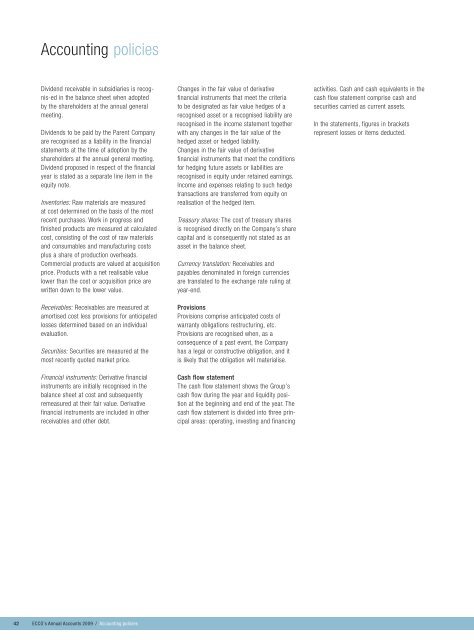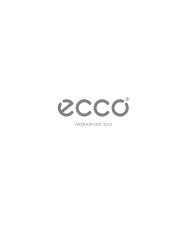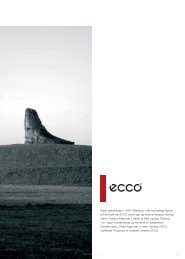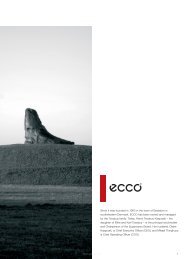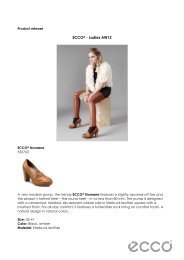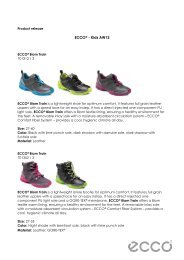Annual Report 2009 - Ecco
Annual Report 2009 - Ecco
Annual Report 2009 - Ecco
You also want an ePaper? Increase the reach of your titles
YUMPU automatically turns print PDFs into web optimized ePapers that Google loves.
42<br />
Accounting policies<br />
Dividend receivable in subsidiaries is recognis-ed<br />
in the balance sheet when adopted<br />
by the shareholders at the annual general<br />
meeting.<br />
Dividends to be paid by the Parent Company<br />
are recognised as a liability in the financial<br />
statements at the time of adoption by the<br />
shareholders at the annual general meeting.<br />
Dividend proposed in respect of the financial<br />
year is stated as a separate line item in the<br />
equity note.<br />
Inventories: Raw materials are measured<br />
at cost determined on the basis of the most<br />
recent purchases. Work in progress and<br />
finished products are measured at calculated<br />
cost, consisting of the cost of raw materials<br />
and consumables and manufacturing costs<br />
plus a share of production overheads.<br />
Commercial products are valued at acquisition<br />
price. Products with a net realisable value<br />
lower than the cost or acquisition price are<br />
written down to the lower value.<br />
Receivables: Receivables are measured at<br />
amortised cost less provisions for anticipated<br />
losses determined based on an individual<br />
evaluation.<br />
Securities: Securities are measured at the<br />
most recently quoted market price.<br />
Financial instruments: Derivative financial<br />
instruments are initially recognised in the<br />
balance sheet at cost and subsequently<br />
remeasured at their fair value. Derivative<br />
financial instruments are included in other<br />
receivables and other debt.<br />
ECCO’s <strong>Annual</strong> Accounts <strong>2009</strong> / Accounting policies<br />
Changes in the fair value of derivative<br />
financial instruments that meet the criteria<br />
to be designated as fair value hedges of a<br />
recognised asset or a recognised liability are<br />
recognised in the income statement together<br />
with any changes in the fair value of the<br />
hedged asset or hedged liability.<br />
Changes in the fair value of derivative<br />
financial instruments that meet the conditions<br />
for hedging future assets or liabilities are<br />
recognised in equity under retained earnings.<br />
Income and expenses relating to such hedge<br />
transactions are transferred from equity on<br />
realisation of the hedged item.<br />
Treasury shares: The cost of treasury shares<br />
is recognised directly on the Company’s share<br />
capital and is consequently not stated as an<br />
asset in the balance sheet.<br />
Currency translation: Receivables and<br />
payables denominated in foreign currencies<br />
are translated to the exchange rate ruling at<br />
year-end.<br />
Provisions<br />
Provisions comprise anticipated costs of<br />
warranty obligations restructuring, etc.<br />
Provisions are recognised when, as a<br />
consequence of a past event, the Company<br />
has a legal or constructive obligation, and it<br />
is likely that the obligation will materialise.<br />
Cash flow statement<br />
The cash flow statement shows the Group’s<br />
cash flow during the year and liquidity position<br />
at the beginning and end of the year. The<br />
cash flow statement is divided into three principal<br />
areas: operating, investing and financing<br />
activities. Cash and cash equivalents in the<br />
cash flow statement comprise cash and<br />
securities carried as current assets.<br />
In the statements, figures in brackets<br />
represent losses or items deducted.


